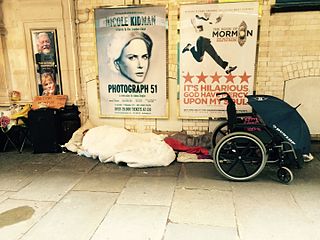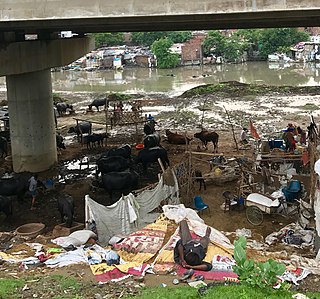Related Research Articles

Homelessness in the United States refers to the issue of homelessness in the United States, a condition wherein people lack a fixed, regular, and adequate residence. The number of homeless people varies from different federal government accounts. In 2014, approximately 1.5 million sheltered homeless people were counted. In 2018, the Department of Housing and Urban Development estimated roughly 553,000 homeless people in the United States on a given night, or 0.17% of the population. Approximately 65% were sheltered in provided housing while 35% were unsheltered. Annual federal HUD reports contradict private state and local reports where homelessness is shown to have increased each year since 2014 across several major American cities, with 40 percent increases noted in 2017 and in 2019.

Homeless shelters are a type of homeless service agency which provide temporary residence for homeless individuals and families. Shelters exist to provide residents with safety and protection from exposure to the weather while simultaneously reducing the environmental impact on the community. They are similar to, but distinguishable from, various types of emergency shelters, which are typically operated for specific circumstances and populations—fleeing natural disasters or abusive social circumstances. Extreme weather conditions create problems similar to disaster management scenarios, and are handled with warming centers, which typically operate for short durations during adverse weather.

Street children are poor or homeless children who live on the streets of a city, town, or village. Homeless youth are often called street kids or street child; the definition of street children is contested, but many practitioners and policymakers use UNICEF's concept of boys and girls, aged under 18 years, for whom "the street" has become home and/or their source of livelihood, and who are inadequately protected or supervised. Street girls are sometimes called gamines, a term that is also used for Colombian street children of either sex.

Out of 10,000 female individuals 13 are homeless. Although studies reflect that there are many differences among women suffering homelessness and there is no universal experience, the average homeless woman is 35 years old, has children, is a member of a minority community, and has experienced homelessness more than once in their lifetime.

Homelessness in Australia is a social issue concerning the number of people in Australia that are considered to be homeless. There are no internationally agreed upon definitions of homelessness, making it difficult to compare levels of homelessness across countries. A majority of people experiencing homelessness long-term in Australia are found in the large cities of Sydney, Melbourne, Brisbane and Perth. It is estimated that on any given night approximately 116,000 people will be homeless and many more are living in insecure housing, "one step away from being homeless". A person who does not obtain any shelter is often described as sleeping 'rough'.

Homelessness in the United Kingdom is measured and responded to in differing ways in England, in Scotland, Wales and Northern Ireland but affects people living in all areas of the countries.

Domestic violence is violence or other abuse that occurs in a domestic setting, such as in a marriage or cohabitation. Domestic violence is often used as a synonym for intimate partner violence, which is committed by one of the people in an intimate relationship against the other person, and can take place in relationships or between former spouses or partners. In its broadest sense, domestic violence also involves violence against children, parents, or the elderly. It can assume multiple forms, including physical, verbal, emotional, economic, religious, reproductive, or sexual abuse. It can range from subtle, coercive forms to marital rape and other violent physical abuse, such as choking, beating, female genital mutilation, and acid throwing that may result in disfigurement or death, and includes the use of technology to harass, control, monitor, stalk or hack. Domestic murder includes stoning, bride burning, honor killing, and dowry death, which sometimes involves non-cohabitating family members. In 2015, the United Kingdom's Home Office widened the definition of domestic violence to include coercive control.

Homelessness or houselessness – also known as a state of being unhoused or unsheltered – is the condition of lacking stable, safe, and adequate housing. People can be categorized as homeless if they are:
Thailand is a centre for child sex tourism and child prostitution. Even though domestic and international authorities work to protect children from sexual abuse, the problem still persists in Thailand and many other Southeast Asian countries. Child prostitution, like other forms of child sexual abuse, not only causes death and high morbidity rates in millions of children but also violates their rights and dignity.

India has a very high volume of child trafficking. As many as one child disappears every eight minutes, according to the National Crime Records Bureau. In some cases, children are taken from their homes to be bought and sold in the market. In other cases, children are tricked into the hands of traffickers by being presented an opportunity for a job, when in reality, upon arrival they become enslaved. In India, there are many children trafficked for various reasons such as labor, begging, and sexual exploitation. Because of the nature of this crime; it is hard to track; and due to the poor enforcement of laws, it is difficult to prevent. Due to the nature of this crime, it is only possible to have estimates of figures regarding the issue. India is a prime area for child trafficking to occur, as many of those trafficked are from, travel through or destined to go to India. Though most of the trafficking occurs within the country, there is also a significant number of children trafficked from Nepal and Bangladesh. There are many different causes that lead to child trafficking, with the primary reasons being poverty, weak law enforcement, and a lack of good quality public education. The traffickers that take advantage of children can be from another area in India, or could even know the child personally. Children who return home after being trafficked often face shame in their communities, rather than being welcomed home.
Crisis accommodation is accommodation provided to people experiencing temporary or ongoing conditions of crisis with the aim of removing them from an otherwise harmful environment and allowing them to improve their situations from a safe and stable environment. Situations that may be alleviated through crisis accommodation include but are not limited to homelessness, domestic violence, elder abuse, and child abuse. Crisis accommodation is typically provided through government organisations, not-for-profit organisations and charities. Crisis accommodation is also known as housing subsidies in other words. Crisis accommodation occurs everywhere around the world across various countries. There are other factors like availability of the services and reasons like poverty and accumulation of debt that affect homelessness which needs to be taken into account in order to solve it as more people tend to look for urgent support when they are facing this crisis. Subsidising houses can be an effective way of preventing or reducing homelessness as housing is a basic right to every individual especially children. Solving this crisis can increase family reunification but they are complex than expected as the victims are mostly women and children. In the European countries, third sector organizations (NGOs) like faith-based charity do play some roles in providing temporary accommodation to the homeless. The National Survey of Homeless Assistance providers and clients in Australia stated that about thirty three percent of the homeless people are children. It is difficult to provide these services immediately as the victims are associated with no tenancy rights and their rights of occupants are generally weaker than a regular tenancy.

Homelessness is a major issue in India. The Universal Declaration of Human Rights defines 'homeless' as those who do not live in a regular residence. The United Nations Economic and Social Council Statement has a broader definition for homelessness; it defines homelessness as follows: ‘When we are talking about housing, we are not just talking about four walls and a roof. The right to adequate housing is about security of tenure, affordability, access to services and cultural adequacy. It is about protection from forced eviction and displacement, fighting homelessness, poverty and exclusion. India defines 'homeless' as those who do not live in Census houses, but rather stay on pavements, roadsides, railway platforms, staircases, temples, streets, in pipes, or other open spaces. There are 1.77 million homeless people in India, or 0.15% of the country's total population, according to the 2011 census consisting of single men, women, mothers, the elderly, and the disabled. However, it is argued that the numbers are far greater than accounted by the point in time method. For example, while the Census of 2011 counted 46.724 homeless individuals in Delhi, the Indo-Global Social Service Society counted them to be 88,410, and another organization called the Delhi Development Authority counted them to be 150,000. Furthermore, there is a high proportion of mentally ill and street children in the homeless population. There are 18 million street children in India, the largest number of any country in the world, with 11 million being urban. Finally, more than three million men and women are homeless in India's capital city of New Delhi; the same population in Canada would make up approximately 30 electoral districts. A family of four members has an average of five homeless generations in India.
Domestic violence in China involves violence or abuse by intimate partners or family members against one another. Intimate partner violence (IPV) by the man is the most common type of domestic violence in China; a 2005 American Journal of Public Health report found that 1 out of 4 Chinese women had experienced physical violence from their partner in the past year. Although China acknowledged that domestic violence was a problem in the 1930s, it has only become a visible issue in the past few decades due to economic and social changes in the 1980s.
Homelessness NSW is the peak body organisation representing homelessness services in New South Wales, Australia. Homelessness NSW advocates on behalf of agencies and homeless people across NSW, with a particular focus on single men, single women, families and children.

Family homelessness refers to a family unit who do not have access to long term accommodation due to various circumstances such as socioeconomic status, access to resources and relationship breakdowns. In some Western countries, such as the United States, family homelessness is a new form of poverty, and a fast growing group of the homelessness population. Some American researchers argue that family homelessness is the inevitable result of imbalanced “low-income housing ratio” where there are more low-income households than there are low-cost housing units. A study in 2018 projected a total of 56,342 family households were recognized as homeless. Roughly 16,390 of these people were living in a place not meant for human habitation. It is believed that homeless families make up about a third of the United States’ population, with generally women being the lead of the household.
Homelessness in Germany is a significant social issue, one that is estimated to affect around 678,000 people. Since 2014, there has been a 150% increase in the homeless population within the country due to the inclusion of refugees. Reportedly, around 22,000 of the homeless population are children.
Homelessness in Greece refers to the state or process of sleeping in housing that is below the minimum standard or lacking secure tenure, in relation to the nation of Greece. Austerity measures and the ongoing fiscal crisis have significantly spurred the rise in homelessness in Greece in the 21st century. Instances of homelessness have been dominantly concentrated in the city of Athens. Homelessness remains a relatively under-examined area of social policy in Greece, with the first organised counting for homeless people taking place in May 2018. Governments and non-profit organisations alike have made efforts to counter this phenomenon.
Homelessness in France is a significant social issue that is estimated to affect around 300,000 people - a figure that has doubled since 2012 (141,500) and tripled since 2001 (93,000). Around 185,000 people are currently staying in shelters, some 100,000 are in temporary housing for people seeking asylum and 16,000 live in slums.

Homelessness in South Africa dates back to the apartheid period. Increasing unemployment, lack of affordable housing, social disintegration, and social and economic policies have all been identified as contributing factors to the issue. Some scholars argue that solutions to homelessness in South Africa lie more within the private sphere than in the legal and political spheres.
Even though mathematically more housing than needed is produced in Egypt resulting in millions of vacant homes, large portions of its residents live in inadequate housing that may lack secure tenure, safe drinking water and wastewater treatment, are crowded or are prone to collapse, as better housing is widely unaffordable. While there is also a problem with homelessness especially amongst children.
References
- ↑ Tipple, Graham, and Suzanne Speak. The hidden millions: homelessness in developing countries. Routledge, 2009.
- ↑ Harbi, A., S. Maouche, F. Ousadou, Y. Rouchiche, A. Yelles-Chaouche, M. Merahi, A. Heddar et al. "Macroseismic study of the Zemmouri earthquake of 21 May 2003 (Mw 6.8, Algeria)." Earthquake spectra 23, no. 2 (2007): 315-332.
- ↑ "New Law Leaves Divorced Algerian Women Homeless".
- ↑ Sinha, Sangeeta. "Arab spring: women's empowerment in Algeria." Journal of International Women's Studies 13, no. 5 (2012): 144.
- ↑ Salhi, Zahia Smail. "Algerian women, citizenship, and the ‘Family Code’." Gender & Development 11, no. 3 (2003): 27-35.
